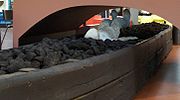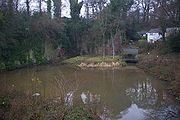
Worsley Navigable Levels
Encyclopedia

Worsley
Worsley is a town in the metropolitan borough of the City of Salford, in Greater Manchester, England. It lies along the course of Worsley Brook, west of Manchester. The M60 motorway bisects the area....
in the City of Salford
City of Salford
The City of Salford is a city and metropolitan borough of Greater Manchester, England. It is named after its largest settlement, Salford, but covers a far larger area which includes the towns of Eccles, Swinton-Pendlebury, Walkden and Irlam which apart from Irlam each have a population of over...
in Greater Manchester
Greater Manchester
Greater Manchester is a metropolitan county in North West England, with a population of 2.6 million. It encompasses one of the largest metropolitan areas in the United Kingdom and comprises ten metropolitan boroughs: Bolton, Bury, Oldham, Rochdale, Stockport, Tameside, Trafford, Wigan, and the...
, England
England
England is a country that is part of the United Kingdom. It shares land borders with Scotland to the north and Wales to the west; the Irish Sea is to the north west, the Celtic Sea to the south west, with the North Sea to the east and the English Channel to the south separating it from continental...
. They were worked largely by the use of underground canals (the navigable levels) and boats called starvationers.
Coal getting is known in the area from as early as 1376 but large-scale development was left until the tenure of Francis Egerton, 3rd Duke of Bridgewater
Francis Egerton, 3rd Duke of Bridgewater
Francis Egerton, 3rd Duke of Bridgewater , known as Lord Francis Egerton until 1748, was a British nobleman, the younger son of the 1st Duke...
.
In the beginning
The first drainage soughSough
A sough is an underground channel for draining water out of a mine. Its ability to drain a mine depends on the bottom of the mine being higher than a neighbouring valley...
was cut into the Earl of Bridgewater's estates in Worsley on the Manchester Coalfield
Manchester Coalfield
The Manchester Coalfield is part of the South East Lancashire Coalfield. Its coal seams were laid down in the Carboniferous period and some easily accessible seams were worked on a small scale from the Middle Ages and extensively from the beginning of the Industrial Revolution in the early 19th...
in 1729 under the auspices of John Massey, the mines agent of Scroop Egerton, the 4th Earl and 1st Duke of Bridgewater
Scroop Egerton, 1st Duke of Bridgewater
Scroop Egerton, 1st Duke of Bridgewater , known as Viscount Brackley from 1687 to 1701 and as the Earl of Bridgewater from 1701 to 1720, was a British peer and courtier...
. This sough was sited to provide drainage for as many mine works as possible in order to make its construction economic. The sough was 1100 yards (1,005.8 m) long with 600 yards (548.6 m) underground. Water in the coal measures
Coal Measures
The Coal Measures is a lithostratigraphical term for the coal-bearing part of the Upper Carboniferous System. It represents the remains of fluvio-deltaic sediment, and consists mainly of clastic rocks interstratified with the beds of coal...
worked above the sough drained into it and deeper coal seams benefited because water needed to be lifted only to the sough not to the surface. This solution to the water drainage problem was successful and extensions of 450 yards (411.5 m) proceeded to allow other coal seams to be drained.
The new Duke
The Dukedom passed to Scroop Egerton's fourth son JohnJohn Egerton, 2nd Duke of Bridgewater
John Egerton, 2nd Duke of Bridgwater , known as Lord John Egerton until 1731 and as Marquess of Brackley from 1731 to 1745, was a British peer....
on Scroop's death in 1745 and when John died in 1748, to Scroop's fifth son Francis, the 3rd Duke of Bridgewater. Francis Egerton gained full control of his estates in 1757 when he was 21 and hired John Gilbert
John Gilbert (agent)
John Gilbert was land agent and engineer to the third Duke of Bridgewater and is credited with the idea which led to the building of the Bridgewater Canal....
as factor for his estates. It was clear to Francis Egerton and John Gilbert that the Duke of Bridgewater's coalmines would need to be much more efficient and productive in order to meet the rise in demand for coal in Manchester
Manchester
Manchester is a city and metropolitan borough in Greater Manchester, England. According to the Office for National Statistics, the 2010 mid-year population estimate for Manchester was 498,800. Manchester lies within one of the UK's largest metropolitan areas, the metropolitan county of Greater...
. One part of their plan was to dig a canal, the Bridgewater Canal
Bridgewater Canal
The Bridgewater Canal connects Runcorn, Manchester and Leigh, in North West England. It was commissioned by Francis Egerton, 3rd Duke of Bridgewater, to transport coal from his mines in Worsley to Manchester...
from Worsley to Salford on the River Irwell
River Irwell
The River Irwell is a long river which flows through the Irwell Valley in the counties of Lancashire and Greater Manchester in North West England. The river's source is at Irwell Springs on Deerplay Moor, approximately north of Bacup, in the parish of Cliviger, Lancashire...
. This idea would improve the transport of coal but not the efficiency of mining. They then had the idea of extending the canal at Worsley underground to produce a navigable level within the coal measures for both drainage and coal transport. A consequence of this decision was that the water from the coalmines proved sufficient to keep the canal in water.
The Bridgewater Canal and the Navigable Level

Act of Parliament
An Act of Parliament is a statute enacted as primary legislation by a national or sub-national parliament. In the Republic of Ireland the term Act of the Oireachtas is used, and in the United States the term Act of Congress is used.In Commonwealth countries, the term is used both in a narrow...
allowing the building of the Bridgewater Canal was passed in 1759. The construction of the canal had already started when James Brindley
James Brindley
James Brindley was an English engineer. He was born in Tunstead, Derbyshire, and lived much of his life in Leek, Staffordshire, becoming one of the most notable engineers of the 18th century.-Early life:...
became involved. Brindley took charge of the canal's construction. Several changes were made to the canal's course under Brindley's control and the canal was completed in 1764. Before and during the construction of the Bridgewater Canal the navigable level was begun and tunnelling progressed. A tunnel 8 feet (2.4 m) high was cut northwards into the rock from the canal level at Worsley providing 4 feet (1.2 m) of headroom and 4 feet (1.2 m) of water. The first workable seam (the Worsley Four Foot mine) was reached in 1761, 770 yards (704.1 m) from the tunnel's portal. The tunnel was not straight, it changed course in order to avoid trespassing under the land of neighbouring landlords. As new coal seams were intercepted branch levels into the seams were dug and extended as the coals were mined. The branch level along the Four Feet seam itself reached a length of 1.75 miles (2.8 km). Mine shafts were sunk and coal mined ahead of the intended line of the main navigable level which was continually lengthened for many years reaching a length of 4 miles (6.4 km). In order to ease the congestion resulting from the large number of boats using the level a second entrance tunnel was dug, 500 yards (457.2 m) long and a one way system introduced.
The Upper Navigable Level
In 1773 an upper navigable level was created by widening the original drainage sough with a finished length of 1.75 miles (2.8 km) and draining into the main navigable level. A sloped branch was driven from the upper level to the surface at a gradient of 1 in 4 to allow boats to be drawn up and lowered down. This incline was later continued downwards to the main level. Further navigable levels were dug below the main level to serve deeper seams, these were 57 yards (52.1 m) and 83 yards (75.9 m) deeper.The Underground Incline
Coals were moved between levels using vertical shafts until 1797, when an underground canal inclined planeCanal inclined plane
An inclined plane is a system used on some canals for raising boats between different water levels. Boats may be conveyed afloat, in caissons, or may be carried in cradles or slings. It can be considered as a specialised type of cable railway....
started in 1795 was completed. It was 453 feet (138.1 m) long and raised boats 106 in 6 in (32.46 m) . There were two locks at the upper level from which two railway tracks descended to the lower main level. Boats entered the upper locks and were seated on wagons. The water was drained from the locks and the boats would descend the incline counterbalanced by a second empty boat ascending the parallel railway line. This incline worked until 1822 and the levels were used for coal transport until 1887, by which time the total length of navigable levels was 46 miles (74 km). The navigable levels continued to be used for drainage with regular inspections by boat until final closure in 1968. The Duke of Bridgewater's heir was Francis Egerton, 8th Earl of Bridgewater
Francis Egerton, 8th Earl of Bridgewater
Francis Henry Egerton, 8th Earl of Bridgewater , known as Francis Egerton until 1823, was a noted British eccentric, and supporter of natural theology....
, who wrote a 47 page book on the subject of the underground canal entitled "Description du Plan Incliné Souterrain" in 1812 whilst resident in Paris
Paris
Paris is the capital and largest city in France, situated on the river Seine, in northern France, at the heart of the Île-de-France region...
, France
France
The French Republic , The French Republic , The French Republic , (commonly known as France , is a unitary semi-presidential republic in Western Europe with several overseas territories and islands located on other continents and in the Indian, Pacific, and Atlantic oceans. Metropolitan France...
.
See also
- Canals of Great Britain
- History of the British canal systemHistory of the British canal systemThe British canal system of water transport played a vital role in the United Kingdom's Industrial Revolution at a time when roads were only just emerging from the medieval mud and long trains of pack horses were the only means of "mass" transit by road of raw materials and finished products The...
- List of canal tunnels in Great Britain

